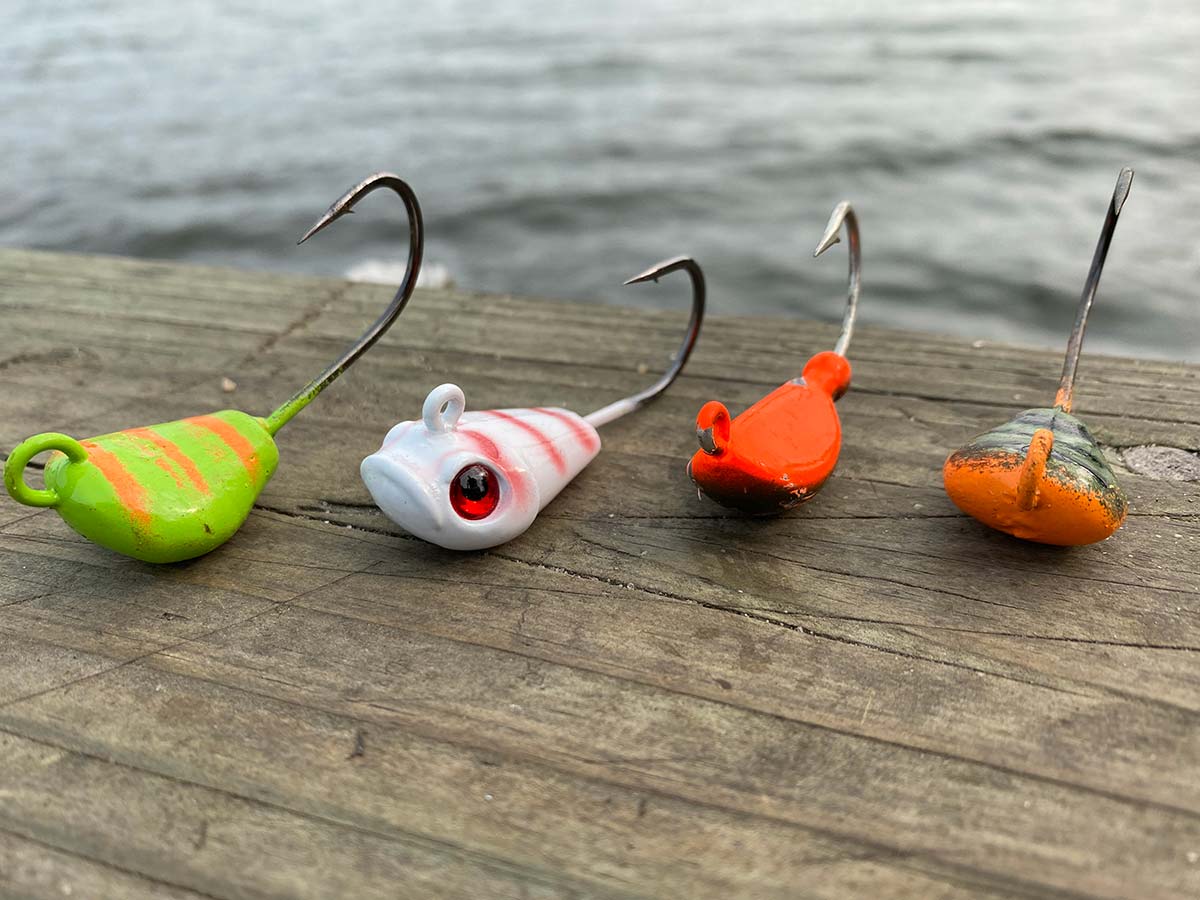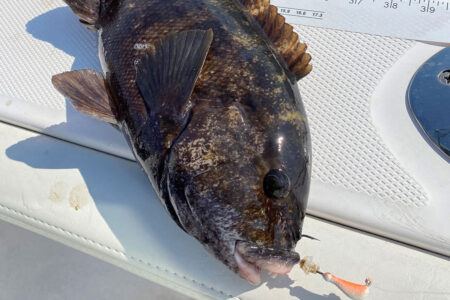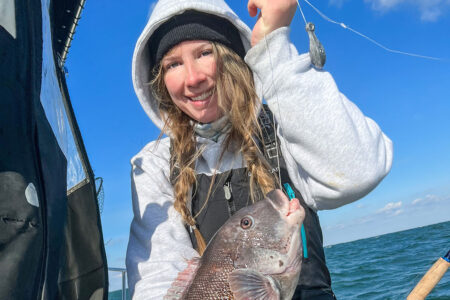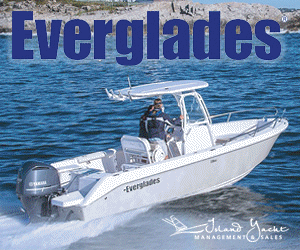
Blackfish jigs are the perfect tool for targeting early season blackfish in Long Island Sound.
To be quite candid, several seasons had come and gone from the time the blackfish jigging craze began, before I sent one of those psychedelic colored lima bean jigs down into their rocky lairs. We were fishing south of buoy 11 in the Eaton’s Neck Triangle aboard Dan and Kevin Donoghue’s 22-foot Tidewater, where the father and son team were doing a good job of showing me up with their ability to score several nice tog each on ¾-ounce jigs. I eventually caught on enough to nail a few shorts but failed to put a keeper in the box.
On the cruise home I sat quietly in the stern licking my wounds, since after all, I was supposed to be a “tog sharpie.” Forty-plus years of fishing ocean wrecks may have taught me a thing or two about togging, but I quickly learned that employing jigs for blackfish in Long Island Sound is a whole new ballgame. Although many days of jigging blackfish along the North Shore have come and gone since that day several years back, by no means do I consider myself a sharpshooter where jigging for tog is concerned. However, I have picked up some pointers and tips that may come in handy if you plan on giving this technique a try this month.
Rocks Galore
 The Island’s North Shore is blessed with lots of rocks in shallow water close to shore, which is where most blackfish will concentrate during the early part of the season. Most rocky points and shorelines from Stepping Stones to the west, and east to Orient Point will hold plenty of blackfish during October. As autumn quickly fades to fall, and the waters of Long Island Sound begin to cool, blackfish begin their fall migration into the rocky shallows. During the early part of October, blackfish will be sharing their rocky lairs with sand porgies and pin sea bass until water temperatures drop to around 55 degrees, at which time most baby scup and biscuits will head to deeper water. Back along the rocky shoreline, blackfish will hold down the fort until water temperatures plummet below 50 degrees, when they will move off to deeper, warmer water in the 50- to 55-degree range. As water temperatures drop below 50 degrees, which on the Sound usually occurs around mid-December, the tog develop a whitish pale tone and go into a semi- dormant state until spring.
The Island’s North Shore is blessed with lots of rocks in shallow water close to shore, which is where most blackfish will concentrate during the early part of the season. Most rocky points and shorelines from Stepping Stones to the west, and east to Orient Point will hold plenty of blackfish during October. As autumn quickly fades to fall, and the waters of Long Island Sound begin to cool, blackfish begin their fall migration into the rocky shallows. During the early part of October, blackfish will be sharing their rocky lairs with sand porgies and pin sea bass until water temperatures drop to around 55 degrees, at which time most baby scup and biscuits will head to deeper water. Back along the rocky shoreline, blackfish will hold down the fort until water temperatures plummet below 50 degrees, when they will move off to deeper, warmer water in the 50- to 55-degree range. As water temperatures drop below 50 degrees, which on the Sound usually occurs around mid-December, the tog develop a whitish pale tone and go into a semi- dormant state until spring.
Rocky shorelines contain groins or barriers to prevent beach erosion, while just about every point has a spillover of boulders leaking into the waters off of those points. Most of the toughest terrain rests in depths from 20 to 30 feet, which is perfect for tog to settle into. While the west end of the Sound sees a good influx of keeper tog by mid-October, the bite spreads and peaks by early November as you travel east. Most of the shoreline will have a healthy mix of blackfish ranging from shorts to 6 pounds, but some white chins from 8 to 10 pounds are always a possibility. Areas like Bayville Reef, Eaton’s Neck Triangle, Sunken Meadow, Cranes Neck, Smithtown Reef and Old Field Point generally give up tog to 6 pounds, while areas such as Cedar Beach, Wildwood State Park, Truman Beach, Hortons, Mulford and Rocky points will often produce some better fish to 8 pounds.
Better Than Rigs
 Many sharpies know the advantages of blackfish jigs are numerous and hard to ignore. The dappled color scheme of green and orange was designed to make the jig blend in among the filtered light and varied bottom structure where blackfish thrive. Many manufacturers have jumped on the bandwagon with several different designs, however, the bean-shaped design of most tog jigs slice nicely through the water column, allowing anglers to significantly downsize their payload from the typical 3 to 4 ounces of lead to jigs of 1 ounce or less.
Many sharpies know the advantages of blackfish jigs are numerous and hard to ignore. The dappled color scheme of green and orange was designed to make the jig blend in among the filtered light and varied bottom structure where blackfish thrive. Many manufacturers have jumped on the bandwagon with several different designs, however, the bean-shaped design of most tog jigs slice nicely through the water column, allowing anglers to significantly downsize their payload from the typical 3 to 4 ounces of lead to jigs of 1 ounce or less.
Unlike the typical bottom rig, jigs can be used to prod every nook and crevice where tog might be hiding. And, contrary to what most tog anglers fear, hang ups are far less common than with a baited rig. The compact nature of the jig and the fact that the hook rides up is the main reason why the jig is out of harm’s way during much of the retrieve. Fishing a jig requires the angler to keep it moving. In fact, a crew that works together will often move along the deck, walking the jig along the bottom and probing every likely blackfish lair. As for those odd shapes and in some cases, various colors, it’s your pocketbook and choice. However, I’ve been happy with the results of the lima bean shape and orange/green color that continues to produce well for me.
Get Crabby
It’s not just the jig that entices the tog, adding crab to the jig makes the combo nearly irresistible to a hungry blackfish. Although blackfish will crunch up all manner of crabs, including rock, green and hermit crabs, Asian crabs are on the A-List when fishing rocky terrain. Using them whole by running the hook right through the middle of their bodies is the ticket. Understand that in recent years Asian crabs have plagued the rocky shorelines that protrude along much of the Northeast. To obtain a day’s supply is as simple as visiting a rocky shoreline along the North Shore during low tide, turn over a few stones and the Asian crabs will try to scat away very quickly, so be ready for a chase.
If you plan on fishing the crabs in a day or two, you can keep them healthy in a container in the fridge. If not, a few days out of the water will have them perishing, which will cause your spouse to throw you and the awful smelling crabs out. The best-case scenario is if you can keep a live baitwell at boat side. Then you can keep the crabs lively for as long as you please. Green crabs are the easiest to obtain and are available in most tackle shops during the fall. They are very effective and in fact, there are times the greenies will out fish the Asians, therefore make sure to have at least a half bushel, especially if you have a place to store them boat side. Stone crabs (aka white crabs) are a natural enemy to the tog and are a top notch bait later in the season when the water becomes cool and the tog relocate in deep water.
Keep It Light

Later in the fall when I switch over to deep-water wrecks in the eastern Sound or in the ocean, spinning tackle is not an option as it is much too awkward and greatly reduces the chance of putting any real white chins on the boat. However, where applying jigs for tautog is concerned along the Sound, I wouldn’t leave the dock without spinning and bait casting tackle in the 15- to 20-pound class matched with a 3000 series spinning or low-profile reel. A rod in the 7-foot range in the 15- to 20-pound class should provide just the right backbone at the tip to pry any stubborn tog out of most cubby holes. Pack your reel with 20-pound braid and an 8- to 10-foot leader of 20- to 30-pound fluorocarbon top shot will round out the tackle end. Be sure to check and feel for frays in the line on each retrieve.
Choosing fluorocarbon over nylon or mono leader is paramount in water less than 30 feet deep. Some anglers may disagree, however many of my seasoned blackfish friends, myself included, believe you don’t leave home without fluorocarbon. To add to it, the lightest pound test you can possibly get away with, the better the chance of keeping busy with quality fish, whereas mono or nylon can result in a slow pick of small fish at best. I’ve witnessed this scenario more times than I care to admit. Then again, when the chew is fast and furious, it won’t matter what you send those jigs down with.
When I began learning the ropes on how to catch blackfish some 45-years ago, I started by reading articles from this very magazine, which hit you up for a measly dime at the newsstands those days. I can recall features stating how cunning and crafty blackfish were and if you were fast enough to hook them, you could hook just about anything that swims. As I remember, all the articles shared one key note, ignore the soft nibbles and wait until you feel a solid tug. I’m sure the authors that compiled those articles those days had it right, but it took this 14-year-old at the time quite a few rodeos before being able to get the hang of it. Therefore, if you lack experience with a jig, and are waiting for that solid tug, don’t hold your breath.
The fact is you can throw away any theories that apply to deep-water tog fishing as it won’t cut it where jigs are concerned. Often you will not feel the blackfish hit a jig, especially when the jigs are less than an ounce. Most times as the jig falls in front of a blackfish, they will swallow the crab and jig whole, going undetected as it bypasses their large conical teeth and powerful jaw, and settling in their second set of teeth known a crushers. Once the crab has been consumed, tog will spit the jig and the bite will often go unnoticed by unsuspecting anglers. Sensitive rod tips and braided lines are imperative to detect even the slightest touch. Steady and slow uplifts as you move the jig along the bottom will keep you in the game with the best of them.
Anchoring Up
Centre Island Reef: 40 55.003 / 73 31.03
Matinecock Reef: 40 54.57 / 73 37.74
Smithtown Reef: 40 55.97 / 73 11.17
Stratford Shoals: 41 06.00 / 73 10.60
Orient Point Light: 41 16.40 / 72 22.40
Little Gull Light: 41 20.11 / 72 11.70
Old Field Point 40 97.00 / 73 11.00
Cranes Neck: 40 96.18 / 73 15.73
Some basic knowledge and your GPS can put you pretty much where you want to be. Good anchoring skills for blackfish are imperative, especially among the rocks and strong currents. Anchors must have an ample supply of line to hold and move around over structure. Keep in mind that the productive depth may vary, so make sure you have enough line to handle depths from 20 to 50 feet. Since there is always the possibility of the anchor getting wedged in between rocks, you should always have a backup plan with at least another anchor, chain and rope. Speaking of chain, be sure to have a least 12 feet of solid galvanized chain that is suited for the size anchor you employ. Remember, the longer the chain the quicker it will set, giving better control when setting up over a preferred spot. When it becomes time to lift the anchor, you’ll want to resort to an anchor ball which makes life a lot easier. This is especially true during hard currents when the anchor can become especially tough to lift.
Lastly, keep in mind that the Sound can chop up and become unstable in a matter of minutes. Winds from the south and southwest are ideal as well as light winds from the north and west. If the forecast is for the wind to blow hard out of the northwest, plan for another day, especially fishing so close to the exposed rocks. Make sure your VHF is in good working order and the PFDs are within easy reach of everyone on board. As always, please practice self-restraint and stay within the limits of the law.




